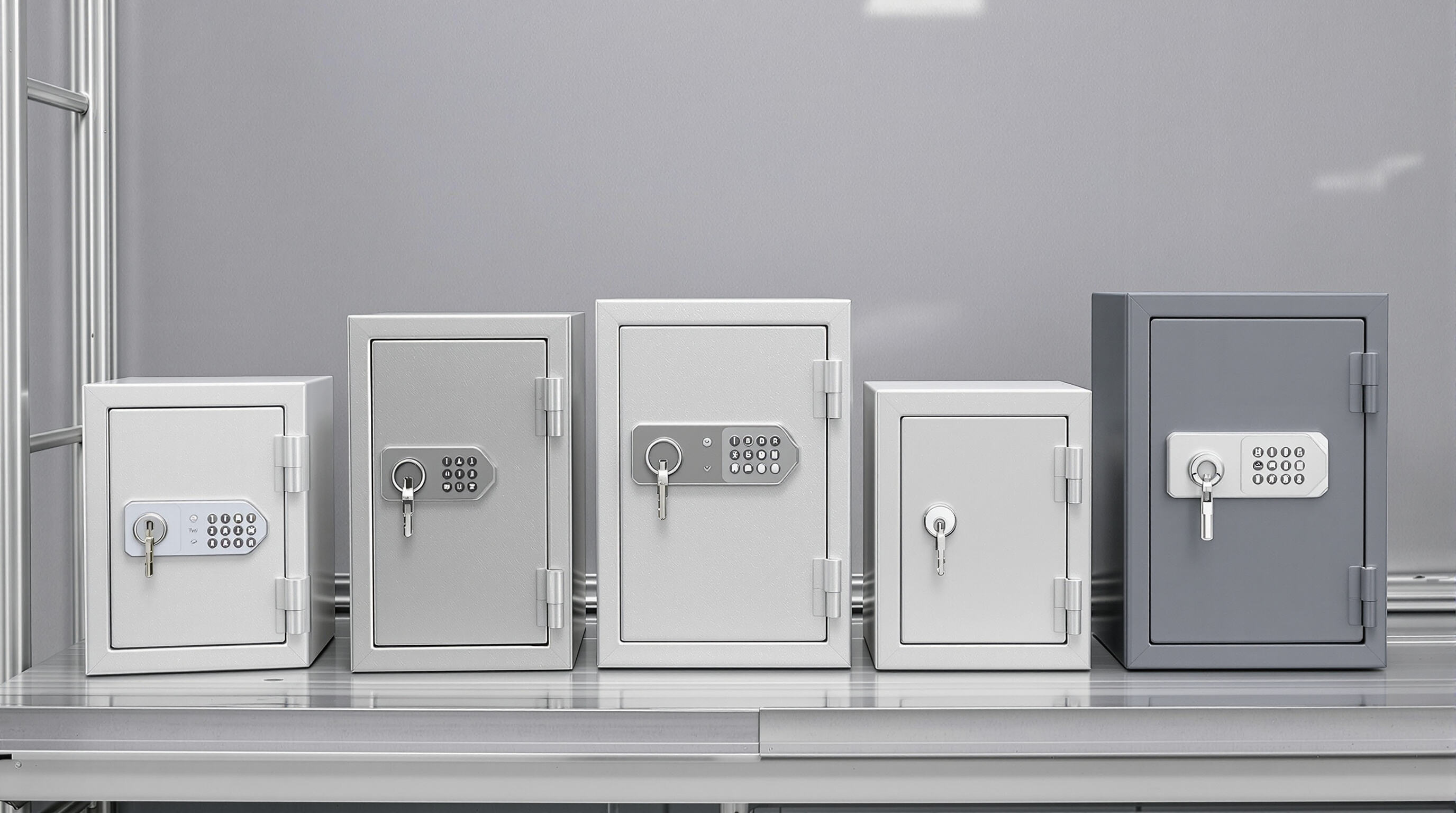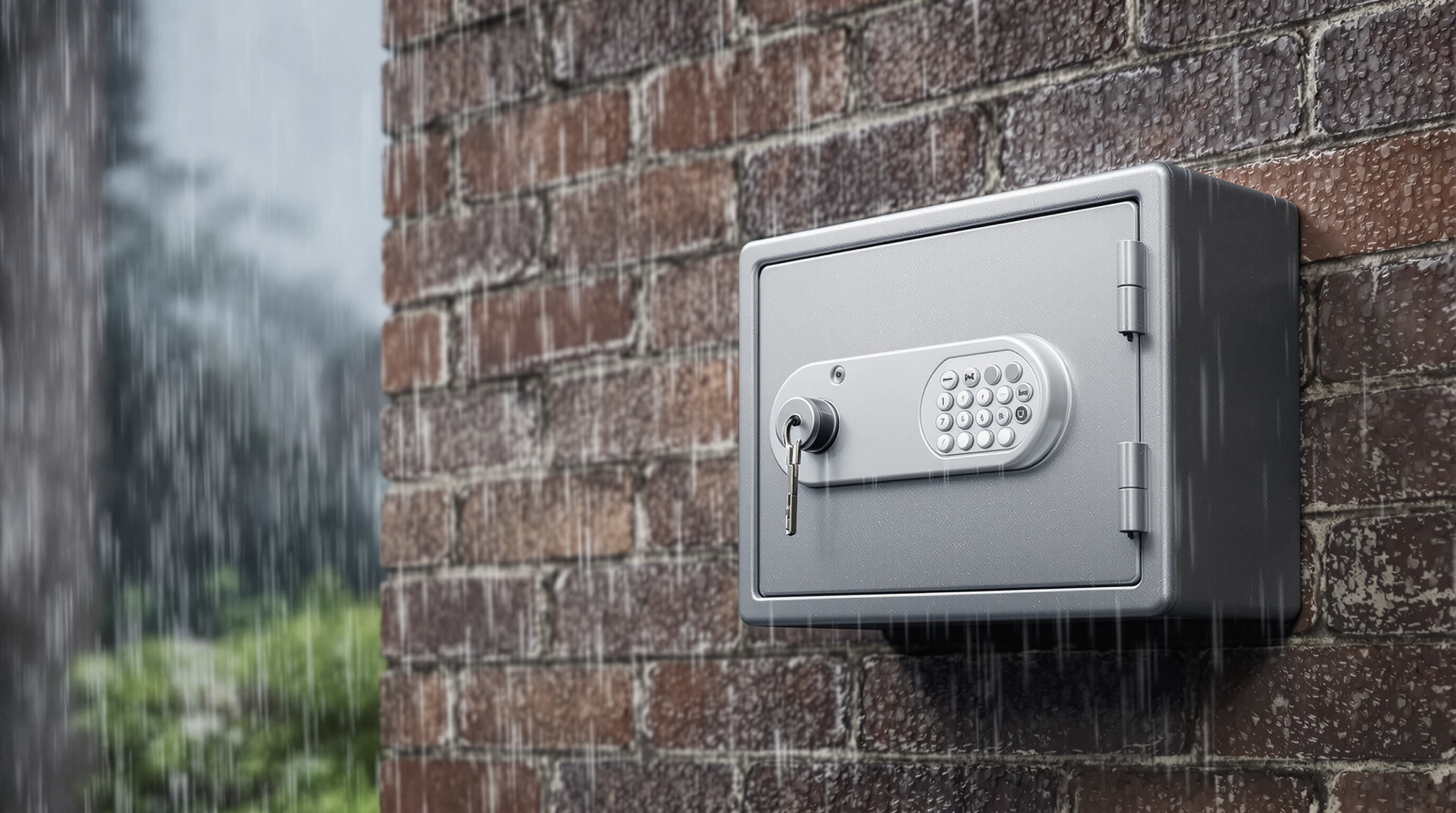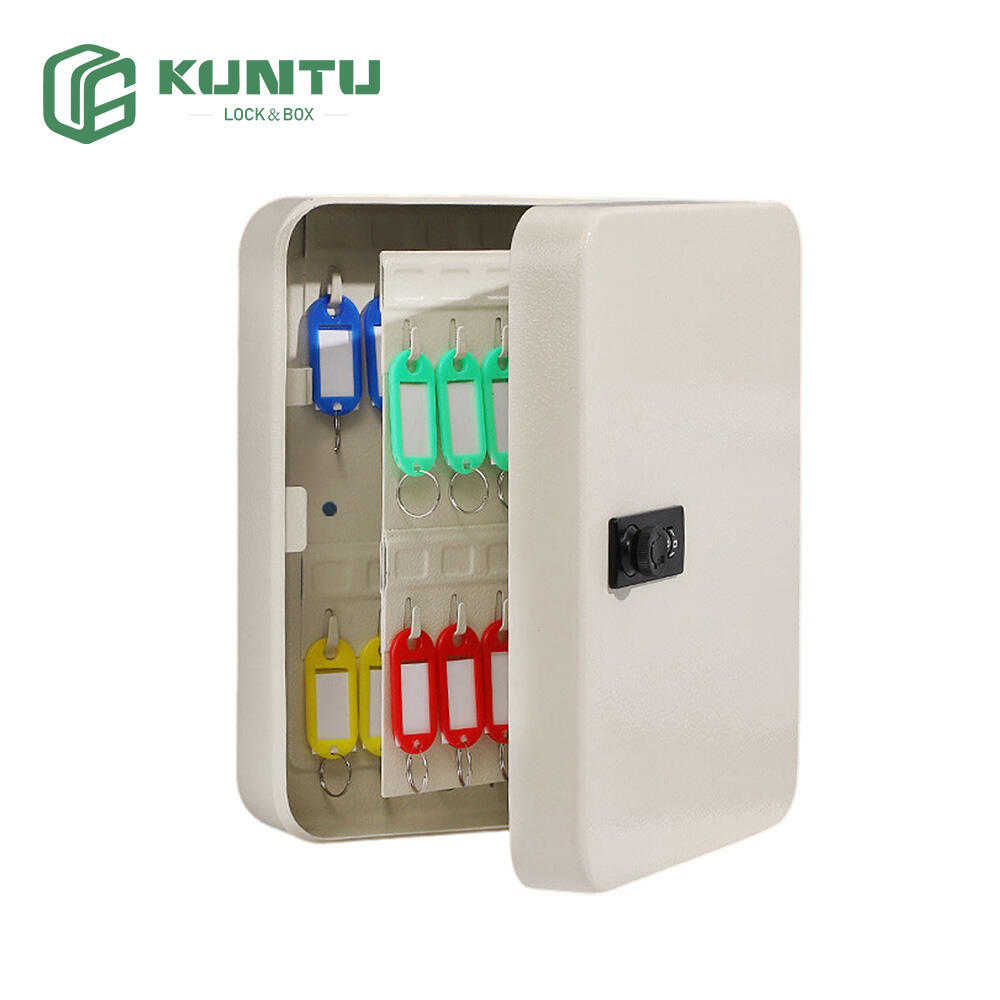Materials and Build Quality: What Makes a Key Safe Lock Box Truly Durable

Stainless Steel, Hardened Alloys, and Composite Polymers: Comparing Materials for Long-Term Durability
The best quality key safe lock boxes typically depend on about three main materials to ensure they last over time. Stainless steel varieties such as grade 304 and 316 are most commonly used in top security models because they resist rust so well, which matters a lot near the coast or anywhere humidity is consistently high. Boron steel and similar hardened alloys work great against people trying to drill through them, according to some makers who claim their products had around 85 percent fewer break ins during those standard penetration tests mentioned in the 2023 Safe Security Report. For composite polymer options, these tend to be lighter but still hold up pretty well nowadays thanks to added fiberglass reinforcement that helps fight off both UV damage from sun exposure and strong impacts. When made correctly, these polymer based boxes can actually stand up to being outdoors for years without much trouble.
Wall Thickness, Layered Construction, and Structural Reinforcement in Premium Key Safe Lock Boxes
When talking about durability, we're not just looking at what something is made of but how it's built underneath. The best quality products typically have steel walls measuring between 2mm and 3mm thick, which is actually double what most cheaper options offer. Inside these premium models, there are cross braces that help prevent bending when someone tries to pry them open. Some manufacturers go even further by combining steel outer layers with special shock absorbing materials inside. This kind of construction spreads out the pressure much better when force is applied. Security experts have tested these reinforced versions and found they can handle over 450 pounds of straight force before showing any signs of damage. Regular models usually start deforming around 150 to 200 pounds instead. These differences make all the difference in real world situations where strength really counts.
Warranty and Real-World Reliability: How Manufacturers Back Their Durability Claims
Top manufacturers back their products with warranties lasting over a decade, typically addressing issues related to materials and damage from weather conditions. Many companies run accelerated testing that mimics around five to seven years worth of sun damage, corrosion from salt air, and extreme temperature changes ranging from below freezing at -40 degrees Fahrenheit all the way up to heatwave conditions at 140 F. These tests have become standard practice across the industry. Independent labs also conduct extensive evaluations such as lock mechanisms being tested for over 200 thousand cycles. Such real world data isn't usually found in glossy brochures but gives customers peace of mind knowing these items will stand the test of time when installed properly.
Do Marketing Claims Match Reality? Evaluating Durability Beyond the Brochure
Stress testing by independent labs shows there's often a big gap between what products promise and how they actually hold up. Most manufacturers these days will say their gear is weatherproof, but according to recent data from the 2024 Security Hardware Review, barely a third of them actually pass the IP65 standard for resisting dust and water entry. When shopping around, buyers need to look beyond marketing speak like "heavy duty" and instead check out products that have real world testing behind them. Look for items that come with proof of performance in harsh conditions or those that have been put through their paces in busy commercial environments where equipment gets constant use. Real test results matter more than fancy labels when it comes to knowing if something will last.
Weatherproof Performance: Protecting Key Safe Lock Boxes in Harsh Outdoor Environments

Outdoor key safe lock boxes face relentless assaults from environmental factors — 91% fail within 5 years due to weather-related damage according to 2023 security hardware testing data. Premium models combine material science with advanced sealing to create weatherproof fortresses rather than mere storage containers.
Resistance to Rain, UV Exposure, and Extreme Temperatures in Outdoor Key Safe Lock Boxes
In direct sunlight, ultraviolet rays can break down cheap plastics about 2.5 times quicker according to the 2024 study on polymer durability. This leads to materials becoming brittle over time while their colors fade away, which ultimately weakens how strong they are. Better quality products incorporate special UV resistant polymers mixed with stainless steel parts designed to handle extreme temperatures ranging between minus 40 degrees Fahrenheit all the way up to 150 degrees without bending out of shape or developing cracks. The triple seal system in these units stops water from getting inside even when it rains sideways, keeping everything inside protected and working properly despite harsh weather conditions outside.
Corrosion-Resistant Materials: Why Rust-Proof Design Matters in Humid and Coastal Climates
Air filled with salt speeds up corrosion about four times faster than what happens in dry areas. Standard steel parts start showing damage within just 18 to 24 months when exposed to this kind of environment. For equipment meant to handle coastal conditions, most manufacturers go with marine grade 316 stainless steel or apply zinc nickel alloy coatings. These materials can last over 1000 hours in those salt spray tests which everyone in the industry looks at as the gold standard for resisting rust. This really matters for second homes on the shore or rental places near beaches where nobody wants to spend time doing regular maintenance every month. That's why building with materials that fight corrosion becomes absolutely essential if these properties need to stay functional without constant repairs.
IP Ratings and Sealing Mechanisms: How Weatherproofing Enhances Durability
Ingress Protection (IP) ratings quantify environmental defense through standardized testing:
| IP Code | Protection Level | Real-World Scenario |
|---|---|---|
| IP65 | Dust-tight + water jet resistance | Mounting under roof overhangs |
| IP66 | Powerful water jets | Direct exposure to storm runoff |
| IP67 | Temporary immersion (1m/30min) | Flood-prone areas |
| IP68 | Continuous underwater use | Permanent poolside installations |
Premium units combine IP67/68 ratings with compression latches and dual-channel drainage to prevent internal condensation—the silent killer of electronic lock mechanisms—ensuring sustained performance in persistently wet conditions.
Tamper and Theft Resistance: Security Features That Enhance Durability
Anti-Pick, Anti-Bump, and Decoding-Resistant Lock Mechanisms in Durable Key Safe Lock Boxes
The best quality key safe lock boxes come equipped with mechanisms designed to resist tampering and stop those common ways people try to get around them. The disc detainer system works because it has those rotating discs inside that need just the right alignment to work properly, which basically makes lock picking and raking tools useless against it. Then there are those anti bump pins with their jagged edges that stop someone from trying to shake open the lock. And don't forget about the false gates built into high security cylinders rated UL 437 these days they really throw off anyone attempting to decode the lock. According to research published by ASTM International back in 2023, all these fancy security features actually make forced entry take about 70 percent longer than regular pin tumbler locks would allow, so burglars end up spending way more time and energy trying to break in without success.
Defense Against Brute-Force Attacks: Drilling, Hammering, and Pry Resistance
Durable models incorporate 4mm hardened steel plates to counter drill attacks and borazon-coated shackles that dull carbide bits within 30 seconds. Pry resistance hinges on three factors:
| Feature | Effectiveness Metric | Industry Standard |
|---|---|---|
| Bolt diameter | 14mm+ resists 18" pry bars | EN 1303:2015 |
| Hinge reinforcement | Withstands 1,200J impact energy | LPS 1175 Issue 8 |
| Seam construction | Laser-welded joints prevent splaying | ASTM F883-19 |
Vibration-dampening epoxy fills cavities to absorb sledgehammer blows, a technique proven in bank vault designs, further enhancing resilience against sustained physical attacks.
Reinforced Shrouds, Anti-Pry Walls, and Physical Hardening in High-Security Models
Military-grade 304 stainless steel shrouds (1.5mm minimum) protect lock cylinders from angle-grinder attacks, while boron-carbide laminates in anti-pry walls require 45 minutes to breach using .5" carbide drills. Leading manufacturers use five-layer construction:
- Tempered glass anti-drill faceplate
- Case-hardened steel outer shell
- Ceramic thermal barrier
- Cross-keyed internal bolts
- Tamper-evident alloy backing
This configuration exceeds the 10-minute forced-entry threshold mandated by Sold Secure Diamond certification, providing measurable defense against professional intrusion tools.
Balancing Security and Accessibility: Can a Key Safe Be Both Durable and User-Friendly?
Durability isn't always about making things complicated these days. Take those backlit Grade 316 stainless steel keypads for instance they stay clearly visible even when the lights go out, and still manage to keep their IP66 water resistance rating intact. The patent pending Secure Smooth dials are another game changer. Tests at Cambridge in 2023 showed these reduced input mistakes by around 83%, which is pretty impressive considering they also meet the tough UL 768 standards for resisting brute force attacks. And let's not forget about the battery compartments equipped with sacrificial fuses that shield internal components from damage during attempted vandalism. These devices maintain operation at an amazing 98% rate through extreme temperatures ranging from -40 degrees Fahrenheit all the way up to 176 degrees. So there we have it proof positive that good design can deliver both rock solid security features and user friendly operation in one package.
Security Certifications and Independent Testing: Measuring Real-World Durability
LPS 1175 and Other Key Safety Certifications: What They Mean for Durability
Security ratings such as LPS 1175 (developed by the Loss Prevention Certification Board) actually test how well key safe lock boxes hold up against various attack methods including drilling, grinding, and cutting attempts. The grading system works this way: items that pass LPS 1175 Grade 1 tests can survive around five minutes of continuous assault, whereas those rated at Grade 5 level manage to resist even professional grade tools for more than ten whole minutes. What makes these standards valuable is that they put actual requirements on components like boron carbide steel plates or special anti-drill mechanisms. Instead of just taking what manufacturers say at face value, these tests give customers something tangible to go on when assessing whether their investment will stand up in practice.
Fire, Water, and Impact Resistance: How Testing Simulates Real-World Threats
Durable key safes undergo standardized stress tests mimicking environmental hazards:
| Test Type | Standard | Real-World Simulation |
|---|---|---|
| Fire Resistance | ASTM E119 | Exposure to 1,700°F for 30 mins |
| Water Ingress | IP66 | High-pressure hose spray |
| Impact Resistance | IK10 | 20 joule blunt force strikes |
These protocols verify components like silicone gaskets and zinc alloy bodies maintain functionality after extreme temperature swings (-40°F to 140°F) or debris impacts, ensuring performance under crisis conditions such as fires or storm damage.
How Independent Ratings Help Verify the Durability of Key Safe Lock Boxes
Testing facilities such as Intertek and UL Solutions put products through their paces with accelerated wear tests that simulate about 5 to 10 years of real world usage. These tests often reveal hidden flaws like rust forming on hinges or plastics breaking down over time. Most manufacturers tout "lifetime durability" claims, but according to SafeHome Research data from last year, just around 12% of key safes kept working properly after being subjected to what amounts to a decade outside in all kinds of weather. What makes independent testing so valuable is how it strips away all the fancy marketing talk and gives actual measurements on things that really matter when buying security hardware anti pry resistance, how strong those shackles are, and whether water will get inside where it shouldn't. For anyone serious about getting good value for money, these real world performance metrics are absolutely essential information.
FAQ
What is the best material for a durable key safe lock box?
Stainless steel, hardened alloys, and composite polymers are commonly used materials for key safe lock boxes due to their resistance to rust, drilling, and UV damage.
How is weatherproofing achieved in key safe lock boxes?
Weatherproofing is achieved through UV-resistant polymers, stainless steel components, triple seal systems, and proper IP ratings, which prevent water ingress and withstand harsh environmental conditions.
What security features resist tampering and theft in key safe lock boxes?
Key safe lock boxes use anti-pick systems, anti-bump pins, false gates, and reinforce the structure against brute-force attacks to enhance security.
Why are independent testing and certifications important for key safe lock boxes?
Independent testing and certifications, like LPS 1175 and ASTM standards, provide verified assessments of durability and resistance to attacks, offering reliable information beyond manufacturer claims.
What are IP ratings, and why are they important?
IP ratings measure the protection level against dust and water ingress; they are crucial for determining how well a key safe lock box can perform in harsh outdoor environments.
Table of Contents
-
Materials and Build Quality: What Makes a Key Safe Lock Box Truly Durable
- Stainless Steel, Hardened Alloys, and Composite Polymers: Comparing Materials for Long-Term Durability
- Wall Thickness, Layered Construction, and Structural Reinforcement in Premium Key Safe Lock Boxes
- Warranty and Real-World Reliability: How Manufacturers Back Their Durability Claims
- Do Marketing Claims Match Reality? Evaluating Durability Beyond the Brochure
- Weatherproof Performance: Protecting Key Safe Lock Boxes in Harsh Outdoor Environments
-
Tamper and Theft Resistance: Security Features That Enhance Durability
- Anti-Pick, Anti-Bump, and Decoding-Resistant Lock Mechanisms in Durable Key Safe Lock Boxes
- Defense Against Brute-Force Attacks: Drilling, Hammering, and Pry Resistance
- Reinforced Shrouds, Anti-Pry Walls, and Physical Hardening in High-Security Models
- Balancing Security and Accessibility: Can a Key Safe Be Both Durable and User-Friendly?
- Security Certifications and Independent Testing: Measuring Real-World Durability
-
FAQ
- What is the best material for a durable key safe lock box?
- How is weatherproofing achieved in key safe lock boxes?
- What security features resist tampering and theft in key safe lock boxes?
- Why are independent testing and certifications important for key safe lock boxes?
- What are IP ratings, and why are they important?

